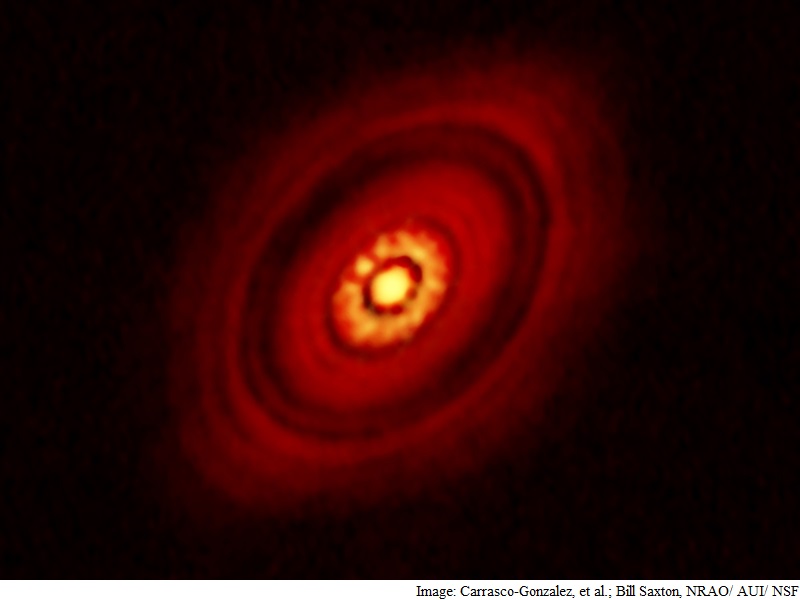- Home
- Science
- Science News
- Astronomers Spot Early Stages of Planet Formation
Astronomers Spot Early Stages of Planet Formation

The scientists used the VLA to see unprecedented detail of the inner portion of a dusty disk surrounding the star, nearly 450 light years from Earth.
The star and its disk were studied in 2014 with Atacama Large Millimeter/submillimeter Array (ALMA), which produced what astronomers then called the best image ever of planet formation in progress, National Radio Astronomy Observatory posted online on Thursday.
The ALMA image showed gaps in the disk, presumably caused by planet-like bodies sweeping out the dust along their orbits.
This image showed in real life what theorists had proposed for years. However, scientists were surprised to see this phenomenon because the star, called HL Tau, is only about a million years old - very young by stellar standards.
The ALMA image showed details of the system in the outer portions of the disk, but in the inner portions of the disk, nearest to the young star, the thicker dust is opaque to the short radio wavelengths received by ALMA.
The new VLA images revealed a distinct clump of dust in the inner region of the disk that contains roughly three to eight times the mass of Earth.
"We believe this clump of dust represents the earliest stage in the formation of protoplanets, and this is the first time we have seen that stage," said Thomas Henning from Max Planck Institute for Astronomy (MPIA).
"This is an important discovery, because we have not yet been able to observe most stages in the process of planet formation," said Carlos Carrasco-Gonzalez from the Institute of Radio Astronomy and Astrophysics (IRyA) in Mexico.
This region, the scientists said, is presumably where Earth-like planets would form, as clumps of dust grow by pulling in material from their surroundings. Eventually, the clumps would gather enough mass to form solid bodies that would continue to grow into planets.
Catch the latest from the Consumer Electronics Show on Gadgets 360, at our CES 2026 hub.
Related Stories
- Samsung Galaxy Unpacked 2025
- ChatGPT
- Redmi Note 14 Pro+
- iPhone 16
- Apple Vision Pro
- Oneplus 12
- OnePlus Nord CE 3 Lite 5G
- iPhone 13
- Xiaomi 14 Pro
- Oppo Find N3
- Tecno Spark Go (2023)
- Realme V30
- Best Phones Under 25000
- Samsung Galaxy S24 Series
- Cryptocurrency
- iQoo 12
- Samsung Galaxy S24 Ultra
- Giottus
- Samsung Galaxy Z Flip 5
- Apple 'Scary Fast'
- Housefull 5
- GoPro Hero 12 Black Review
- Invincible Season 2
- JioGlass
- HD Ready TV
- Laptop Under 50000
- Smartwatch Under 10000
- Latest Mobile Phones
- Compare Phones
- OPPO Reno 15 Pro Max
- Honor Win RT
- Honor Win
- Xiaomi 17 Ultra Leica Edition
- Xiaomi 17 Ultra
- Huawei Nova 15
- Huawei Nova 15 Pro
- Huawei Nova 15 Ultra
- Asus ProArt P16
- MacBook Pro 14-inch (M5, 2025)
- OPPO Pad Air 5
- Huawei MatePad 11.5 (2026)
- Xiaomi Watch 5
- Huawei Watch 10th Anniversary Edition
- Acerpure Nitro Z Series 100-inch QLED TV
- Samsung 43 Inch LED Ultra HD (4K) Smart TV (UA43UE81AFULXL)
- Asus ROG Ally
- Nintendo Switch Lite
- Haier 1.6 Ton 5 Star Inverter Split AC (HSU19G-MZAID5BN-INV)
- Haier 1.6 Ton 5 Star Inverter Split AC (HSU19G-MZAIM5BN-INV)

















